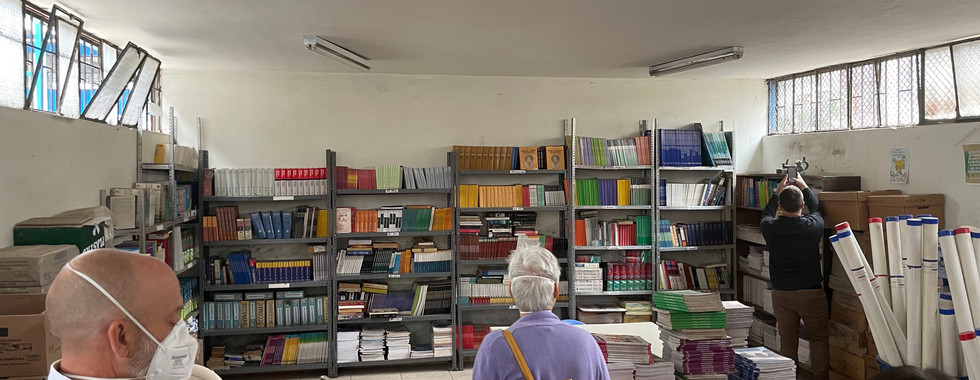First School Visits 6/23/2022
- Kate Strein
- Jun 26, 2022
- 7 min read
Updated: Jun 28, 2022
School Numero Uno - Jorge Chavez Primary & Secondary School
From the moment we stepped foot on this campus, it was apparent that this is a special place. Students are proud to go to this school, teachers are valued and respected here, and the community celebrates the successes. One student, Daniella, told me in perfect English “Welcome to my school, we have the best teachers here.” for a 13 year old, no matter where in the world, this is a profound statement! Though the building and property may not look like much, though they may only have one working computer at a school for 700 students, though their library options aren’t completely age appropriate or a wide range of literary options, the heart of this school is beating loud and proud.
Our visit began with a beautiful welcome tunnel of students cheering, complete with posters with our names, faces, and facts about us. Our formal welcome was by a group of upperclassmen who had a type of honor cord on their uniform (military influence). They sang the Peruvian national anthem, welcomed us in English, and played our anthem, The Star-Spangled Banner. I have to admit, I never knew there were extended verses to the Star Spangled Banner. It was rather embarrassing to have all of us stop singing and stand quietly confused (speaking for myself) as the song continued after the first verse. I looked at the eyes of the students, and they seemed shocked as well. After the formal introductions, we were led on a tour through classrooms, the library, and the technology room (1 working computer, several old, broken HP desktop computers). After some fun interacting with students in the courtyard, we met with teachers, a local school psychologist, a SANA (special education resource) representative in the teachers’ lounge to learn more about their school and have a Q&A session to help with our guiding questions. From this collaboration, I learned that the teachers absolutely have a desire to help students with special needs and from marginalized groups, but they lack the resources and support. Before walking into the school and welcome tunnel, it was announced to us that there was one male student at the end of the line that is mentally disabled. Just the fact that this was announced to us shows us the disconnect between their understanding of acceptance and inclusion. A US teacher would never point this out. I believe that they did this more to celebrate the student than to embarrass or shame him, but it was shocking nonetheless. We were told that the school of 700 students had approximately 26 students diagnosed with learning disabilities or other special needs, but there are most likely more who have not yet been identified and diagnosed. The teachers who serve these students have to rely on collaboration with their colleagues to meet the diverse needs of these students. The SANA representative and school psychologists cover an area of 5 schools, so one can assume that the support and resources are lacking. I asked about the parent's involvement and perception of getting their child diagnosed and help in their learning. Similarly to the US, some parents are compliant and willing to go through the diagnosis process, but others reject the suggestion for testing due to the social and emotional impact it may have on the student with his/her peers.
Next, we discussed behaviors and behavior interventions. Parents are not directly involved with school discipline, and minor offenses can not be disciplined (we were told only fighting could have consequences). Therefore, teachers must learn to deescalate problematic behaviors and work with disruptive students in an attempt to improve their behavior. There is a team of teachers who volunteer their time to help support teachers who may have disruptive students, but it is apparent that there is not a school-wide behavior matrix or discipline plan in place. Though they do not have a positive behavior support system, teachers are devoted to the whole-child approach. This is what makes this school culture so special. It is apparent that teachers love working here and students love learning here. They are not just teaching curriculum, they are devoted to raising good citizens by teaching values or empathy, compassion, and self-awareness. Teachers report that what drives their passion is the collaboration and trust between administration and colleagues. The school day officially runs from 8 a.m. to 1 p.m., but many teachers and students stay in the afternoon for enrichment activities, labs, and projects.
Some problems, other than discipline and special needs resources, are the lack of physical learning resources. As stated above, there is only one working computer in the school, and the technology room is full of old, broken HP desktop computers. The government does not provide funding for technology, though the teachers and students are eager to connect to the world. They do provide Google Classroom for remote learning, but many students lack the access. Though they are lacking resources, they still generate high academic results and always pass the national evaluations with flying colors.
After the teacher collaboration meeting, we were bombarded by students wanting autographs, selfies, and to practice their English skills. I have to admit, this was my favorite part of the visit. I’m naturally drawn to the middle school aged students, and they loved that I was so willing and eager to take selfies and share my Instagram with them. Many have already added me and requested English practice lessons when I return home.

By lunch time, we were all so full of love and adoration for this school and students. It was such an honor to have the few hours to connect and collaborate. With sore cheeks from so much smiling, and a camera full of photos, we loaded our bus and headed to Embarcadero 41 for another 3-course lunch (shout out to Fulbright for feeding us so well, and choosing the most incredible restaurants).
School Visit Numero Dos - Jorge Portocarrero Rebaza Primary & Secondary School
With full bellies and full hearts, we once again loaded the bus and ventured an hour and a half into the foothills to our second destination. We got to see the “real” side of Lima, outside of the ritzy/wealthy Miraflores. Poverty was ever present here, in the types of housing, transportation, and overall lack of resources. It’s natural for my mind to compare to other countries where I’ve experienced extreme poverty, and there are many similarities. However, in every place I notice that people are productive, busy and working, use the resources they have rather than cry about what they’re lacking, and have a strong sense of community, always helping each other. As I’ve mentioned in Haiti numerous times: what they’re lacking in material goods, they make up for in spiritual and community support; and so often we Americans are rich in material goods, but lacking in spiritual connection and community support. I’m always humbled by this, and return home with a better appreciation for the blessings in my life, spiritually, intellectually, and the support and love of the friends and family in my life.
As we approached the school, the energy and excitement that we could feel extending beyond the school walls woke us up from our bumpy bus slumber. This school was ready to blow us away with the most amazing welcome and cultural experience. Again, we were led through a welcome tunnel, but this time they announced each of our names as were escorted by an upperclassmen with military-rank cords, walked through the entire student population AND community members, down to the courtyard where we would enjoy various student performances depicting Peruvian and Inca cultures. I’ve never felt more like a celebrity than I did at this moment. Jhimmy, the Fulbright alum and English teacher, welcomed us (in English) starting with the Lord's Prayer, our national anthem, the Peruvian national anthem (this time in Quechua), and an explanation of the performances that we were about to enjoy. For the next two hours, student groups performed dramatic interpretations and dances depicting parts of Inca culture and representing the three area of Peru: the coastal area, the Andean region, and the Amazonian region. All costumes were made from recycled materials and student-created. WOW! Words cannot begin to describe the beauty and creativity that took place during these performances. It was obvious, from the handmade decorations all over the school, the costumes, and the performances, this school had been preparing for our visit for WEEKS! What an honor.
Following the performances, we were split into groups of primary and secondary teachers. We secondary teachers were led to the upper part of the school, where each content area set up a presentation around another courtyard, and each had a group of students present their learning, as well as provide a small gift of appreciation for us as their guests. I cannot wait to show my students the detail and depth of knowledge these students represent in their projects. They are clearly proud of their learning, and take their education seriously. At the last table, where mathematics was being presented, another student with special needs was pointed out to us. He had some drawings and coloring sheets that he presented to us. Though it was such a beautiful inclusion on behalf of the school, pointing out his disability hurt my heart. He will always know that he is different and doesn’t quite belong. His work was much different than that of the other students, and the applaus and recognition seemed like a forced effort. However, including him is a step in the right direction. He was proud to show us his drawings, and the last one was a commemoration of his late grandfather. When showing us the drawing, he began to cry because he misses his grandfather dearly. It was so beautiful to see his willingness to share his art and open a vulnerability to meer strangers. The crowd changed his name (Donovan) when he finished. I met his mom and thanked her for loving him and providing him with an education and inclusive opportunity. It's not easy raising any child, but raising one with disabilities, especially in a place lacking resources and knowledge of special needs, is especially challenging.
At the conclusion of the presentations, not at 5 pm (students and families voluntarily stayed 4 hours after the normal school hours), we were led to another teacher and administration collaboration. First, we were given a traditional meal of boiled sweet potatoes, corn, and chicken, as well as a fermented corn drink called Chicha. Next, both Peruvian and AMerican teachers introduced themselves and opened discussion for guiding question Q&A. As dusk fell outside, we were all eager to collaborate and connect, and no one seemed bothered by the time or going outside of the schedule. We stayed there past 8 p.m., and most of the peruvian teachers did as well. This was a true testament to the devotion these educators have to their students and schools. Our collaboration preceded any other responsibilities or plans.
At 8:30, almost 4 hours past the scheduled time, we loaded the bus, overwhelmed and exhausted in all the good ways, to head back to the hotel for the evening. A calm, quiet ride back proved that we all took the time to process the beautiful exchanges that happened today at both schools. This truly was one of the best days of my life.























































































Comments